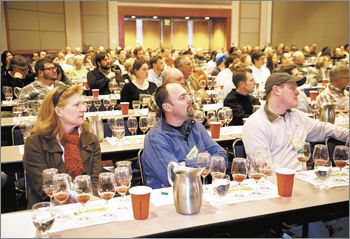State of the Industry


Story By Jennifer Cossey | Photos by Andrea Johnson
The Oregon wine industry has undergone a myriad of changes over the years. And as it continues to evolve and expand, critical questions arise … Where are we now? Where are we going? What’s the best way to get there?
At this year’s Oregon Wine Industry Symposium, Feb. 21–22, answers to these questions and others were explored. At the end of the two-day conference, in-depth discussions enlightened attendees and strategies for success emerged.
Keys to Oregon wine’s growth include: educating consumers, maintaining variety in the market, strengthening direct sales, reaching out to younger generations, strategically preparing for the upcoming vintage and pricing wine competitively.
OREGON FIRST
From our perspective, Oregon wine is big business; but in truth, we are just a small fraction of the national wine industry with sales of about two million cases each year — of nearly 350 million sold — half of which are Pinot Noir. At only one-half of 1 percent, Oregon has serious growth potential, but consumer education is needed. Simply put, we need to sell Oregon first.
NOT JUST PINOT
Only a handful of consumers truly understand Oregon wine, its appellations and sub-appellations, vintage variations and higher costs associated with production. A general misconception is that Oregon only produces Pinot Noir and Pinot Gris — the two major varieties sold nationally. Chardonnay, Viognier, Riesling, Tempranillo, Syrah, Grenache and sparkling wine also sell well but miss the overall Oregon branding message.
Master Sommelier/Master of Wine Doug Frost believes that opportunity is one we shouldn’t miss. “It’s very important that any wine industry diversify,” Frost said. “With tens of thousands of grapes, there is no excuse for not figuring out what grape or style comes next and be prepared for it.”
He says countries like Argentina, New Zealand and Australia have pigeonholed themselves into one product and are in a race to the bottom with pricing. We have a chance to avoid a similar fate by offering our other great wines to the national market.
DIRECT IS BEST
The number of wineries in Oregon has tripled since 1995, while distributorships have shrunk from roughly 3,000 to 675. Competition for space in a distributor’s portfolio has become astronomically high; and with increasing scarcity of distribution networks available, wineries have focused more on direct sales.
In 2010, direct sales grew 12 percent and accounted for 20 percent of Oregon’s entire volume with an 8 percent growth in tasting room sales in the last year alone. Direct sales account for anything and everything direct-to-consumer: tasting room sales, website sales, personal interactions with guests, networking with others in the industry, outreach to partners like restaurants, B&Bs, hotels and tour operators, as well as wine club sales.
SOCIAL MANIA
While experts don’t always agree on which generation to watch, they do concede that younger wine drinkers are important as we find new ways to market Oregon.
Trends show that wine consumption increases as a person ages. Some think that Generation Y — also called the Echo Boomers or the Millennials, born 1982 or later — is the one to monitor as their level of wine consumption is higher than generations earlier, meaning they could become serious wine drinkers sooner than previous generations. Others experts feel that Generation X — born between the early ’60s and 1981 — is the one to follow as they are starting to earn enough money to afford and appreciate fine wine.
Either way, both groups use social media — Twitter, Facebook, Google+ and YouTube — which has now become a key part of a winery’s marketing plan. Consistent, up-to-date and ongoing communication is imperative to reaching the younger demographics.
WEATHER WATCH
This past vintage, winegrowers had a variety of challenges with late picking, low alcohol, high yields and mold pressure. Nature also teased with extremes: 2011 saw the coldest — and one of the wettest — April–June on record and the third warmest September.
In 2012, La Niña is currently waning but still causing stormy weather in Oregon this spring. A transition to neutral conditions in the tropics is projected to bring a warmer, drier summer; add to that cool waters off our coast, and experts expect a spring like last year with slightly lessened extremes and a warmer growing season. To prepare, wineries should ready space for another accelerated harvest with potentially high yields.
PRICE IT RIGHT
Nationally, 2012 is expected to show a 7- to 11-percent increase in fine wine sales. More than 47 million people drink wine once a week or more; that number, and the frequency, is increasing.
Wine drinkers still love Oregon Pinot, so as the economy has improved so have sales. Add to that high yields of 2011 and California’s drop in harvested fruit — down 20 to 35 percent last year — and Oregon has an opportunity to gain some market share.
Experts advise that wineries should take a critical look at their pricing. While many feel that Pinots in the $20 to $30 range is important, it remains the most oversaturated part of the market, and an under $20 product could be an ideal tactic to attract more consumers.
Frost sees two crucial points of opportunity. “First, Oregon needs to continue to support — and not denigrate — these less expensive bottlings. Secondly, Oregon Pinot Noir for less than $35 can be very good to excellent, so it’s crucial that Oregon explain those wines to American consumers and emphasize that Oregon is not interested in a competition with California; rather, it is that Oregon’s genuine style is one of purity and elegance.”
Overall, Oregon still has a long way to go to sustain its growth. You, the consumer, can help ensure its success by telling the story of Oregon wine, letting others know about the fine people in our industry and the quality wines being made all over the state.
Jennifer Cossey is a certified sommelier through the Court of Master Sommeliers and a certified specialist of wine through the Society of Wine Educators. Jennifer also freelances for Sommelier Journal, Northwest Palate Magazine, 1859, Wine Press Northwest, OPB and Mix Magazine.








